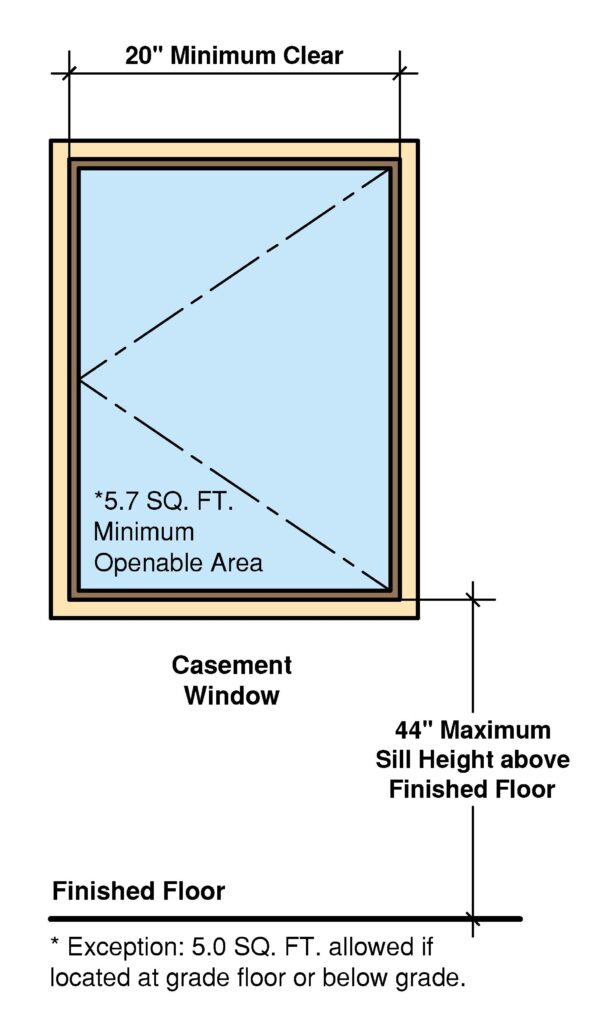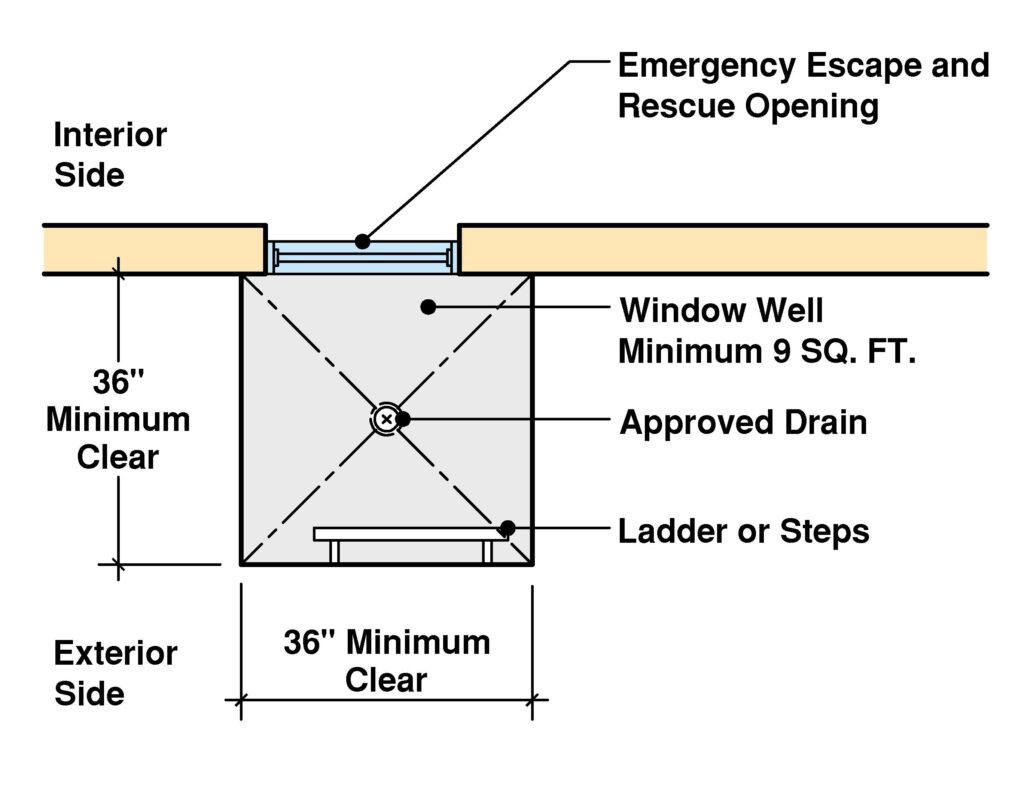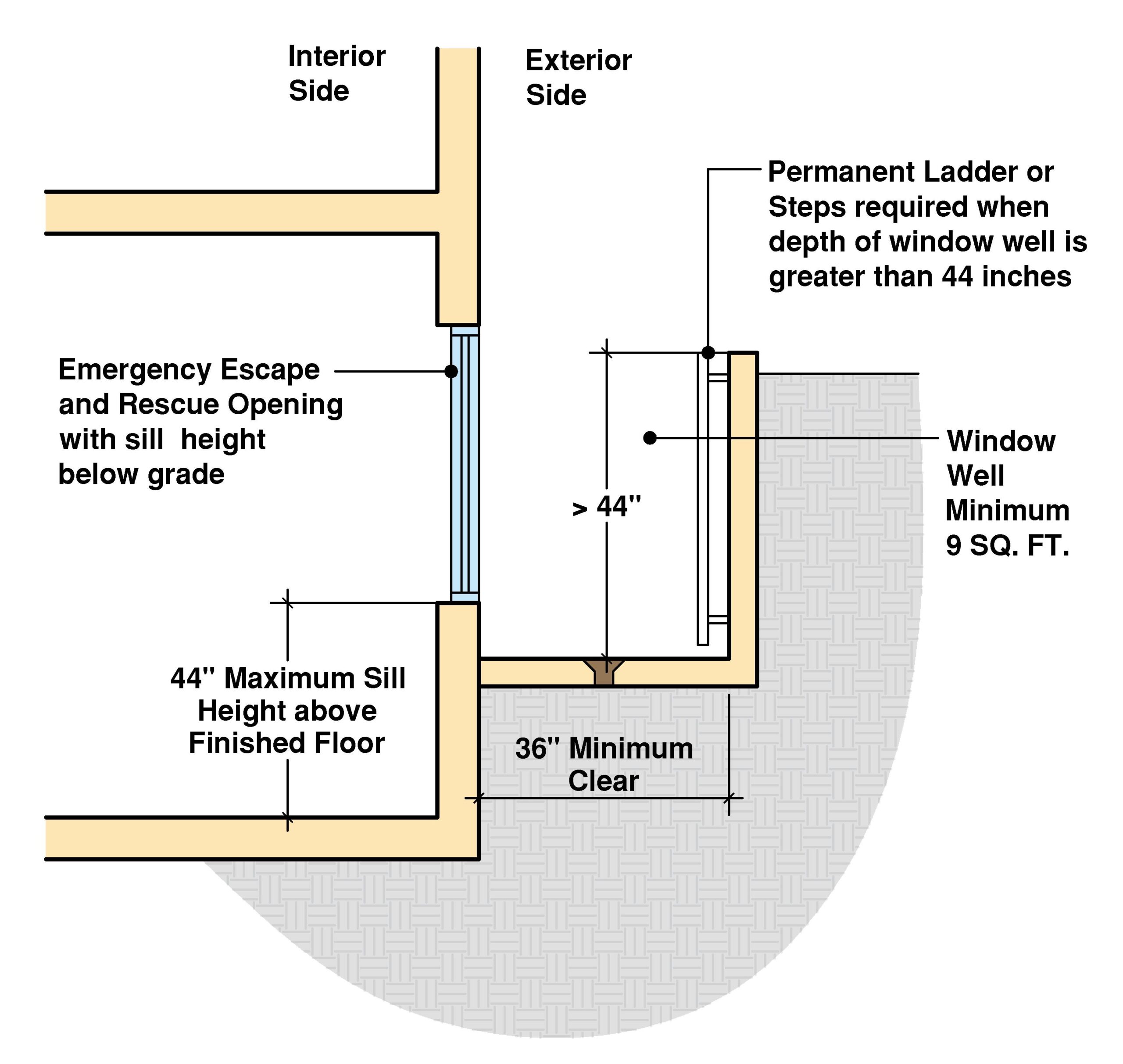Author : Building Code Trainer

Have you ever applied for a building permit to change out your old outdated windows with new energy efficient windows for your home only to find out that some of the windows don’t meet the window egress requirements?
This is a very common problem. Building codes change over time and what was once acceptable in older homes might not be under current code when an alteration occurs.
Please note that these requirements can be specific from city, county, or state therefore it is best to contact your local authority having jurisdiction to see what these requirements are.
As for a general understanding of these requirements, let us look at Section R310 of the 2021 International Residential Code (IRC) for what the minimum standards are. But before we get into what the size requirements are, let us first understand what an egress window is and where it is required.
What is an Egress Window?
An egress window is a window of a certain size that provides a safe exit from a building in case of an emergency. These windows are typically installed in bedrooms, basements, and sleeping rooms to ensure that occupants can escape in the event of a fire, earthquake, or other emergency situation. Egress windows must meet specific size requirements to allow for an easy exit and access.
A lot of people will refer to the term “Egress Windows” when in reality the code references “Emergency Escape and Rescue Opening”. Therefore we will use these terms interchangeable throughout the post but they are basically referring to the same thing. The intent is to provide a means of escape and access for rescue in the event of an emergency, for example a fire.
Again we are referring to the term “Egress Windows” since we are talking about the windows themselves here in this post however the term “Emergency Escape and Rescue Opening” is better to use since the means of escape can be achieved by either an operable exterior window, door, or similar opening that meet the minimum size and dimension requirements within Section R310.
So with that said, we will go over the minimum required window opening sizes as well as where they are required to be located.
Where Are Egress Windows Required? (R310.1)
Egress Window Locations
The code requires every basement, habitable attic, and every sleeping room to have at least one operable emergency escape and rescue opening. If a room is used as such, it must provide a means of escape.
Also note that if basements have multiple sleeping rooms, each sleeping room is individually required to provide a means of escape and rescue. These openings must open directly to the outside such as into a public way, yard, or court having a minimum 36″ width that opens to a public way.
The window also needs to be operational from the inside of the room without much effort.
What is the Minimum Size Requirement of Egress Windows? (R310.2)
Egress Window Size and Dimensions
First lets look at the minimum opening area required. The minimum required dimensions of the window must include compliance with all of the following: the net clear opening area, net clear height opening, and net clear width opening.
- Minimum 5.7 square feet of net clear opening area.
- Exception: 5.0 square feet allowed if located at the grade-floor.
- Minimum 24 inches of net clear height opening.
- Minimum 20 inches of net clear width opening.
These net clear opening dimensions must be provided as a result of normal operation.
Here is a visual look at these clear opening dimensions and how they apply to different window types:
Casement Egress Window
Here is a graphic of what casement windows look like:

Single/Double Hung Egress Window
Here is a graphic of what single-hung and double-hung windows look like:

Horizontal Slider Egress Window
Here is a graphic of what horizontal slider windows look like:

Now when a door is being used to meet the egress requirements, the code requires it to be either a side-hinged door or a sliding door. It must meet the minimum opening area requirements stated above in a fully open position.
Window Sill Height
Also note that if a window is being used to meet the egress requirements, in addition to the above, the sill height of the window (which means the bottom of the clear opening) shall not be more than 44 inches above the finished floor.
Fun Tip: Some windows, like windows located on the second floor, have minimum sill height requirements therefore to learn about Window Fall Protection requirements per the International Residential Code (IRC), be sure to check out this POST.
If you have the time, it is important to check out the post above regarding window wall protection since the sill height now has both a minimum and maximum height when located on a second floor.
The maximum height is required within this egress section and the minimum height is required to ensure adequate fall protection is being provided.
Does a Basement Need an Egress Window?
Basement Egress Windows
Yes, as we noted above the code requires every basement, habitable attic, and every sleeping room to have at least one operable emergency escape and rescue opening.
If a basement contains a habitable room or is used as such, it must be provided with an emergency escape and rescue opening, such as an egress window.
When the sill height of the egress basement window is located below grade (common for egress windows provided for a basement) a window well must be provided.
Window Well Code Requirements (R310.4)
First off it is important to note that in prior code editions new terminology was introduced. For example the 2015 IRC had a section for window wells and a section for bulkhead enclosures. The window well was for windows below grade and the bulkhead enclosure was for doors below grade.
In the 2018 IRC, the term “bulkhead enclosures” was replaced with “area wells”. However in the 2021 IRC, the term “area wells” merged the prior sections of window wells and area wells into one section serving all emergency rescue openings that are below grade.
Important Note: For simplicity, since most people still use the term “window well”, we will continue to refer to this term in this post however please note that the 2021 IRC no longer uses this term and instead uses “area wells”, however the requirements are pretty much the same. Therefore lets look at what those requirements are.
Window Well Size (Area Well Size)
Per Section R310.4.1, the area of a window well shall not be less than 9 square feet with a horizontal length/width of no less than 36 inches. This is to ensure that there will be a sufficient amount of space to allow occupants to escape or for fire fighters to enter.

Window Well Ladders and Steps
Per Section R310.4.2, if the depth of the window well is greater than 44 inches, a ladder or steps are to be provided and permanently fixed to provide access and by no means are allowed to encroach within the required window well dimensions by more than 6 inches.

Window Well Ladder
The inside width dimension of ladders or rungs (a horizontal support on a ladder for a person’s foot) shall not be less than 12 inches and must project no less than 3 inches from the wall.
The vertical spacing shall not be more than 18 inches on center throughout the entire height of the window well.
Window Well Steps
As for the steps, the inside width shall not be less than 12 inches. The minimum tread depth shall be at least 5 inches and the maximum riser height shall not exceed 18 inches.
It is also important to note that the ladder or the steps cannot obstruct the emergency window or door when it is in the fully opened position.
Window Well Drainage
Also since the bottom of the window well is located below grade, providing proper drainage is required by connecting it to the buildings foundation drainage system as required in Section R310.4.3.
Emergency Escape and Rescue Openings in Summary
So this basically sums up the code for egress window requirements and their dimensions. Therefore let us recap on the residential emergency escape and rescue opening requirements:
- Minimum 5.7 square feet of net opening size.
- Exception: 5.0 square feet allowed if located at grade floor or below grade.
- Minimum 24 inches of net height opening.
- Minimum 20 inches of net width opening.
- Maximum 44 inches to window sill measured from finished floor.
- Window wells serving an emergency and rescue opening shall not be less than 9 square feet in area with a horizontal length/width of no less than 36 inches.
- Window wells greater than 44 inches in depth requires a permanently affixed ladder or steps to provide access.
- Permanent ladder or steps cannot encroach the required window well dimensions by more than 6 inches.
- The inside width of a ladder serving a window well shall not be less than 12 inches and must project no less than 3 inches from the wall.
- Vertical spacing of the rungs shall not be more than 18 inches on center.
- Steps must have a minimum width of 12 inches, a minimum tread depth of 5 inches and a maximum riser height of 18 inches.
For more information, see Section R310 of the 2021 International Residential Code for a more in-depth look at emergency escape and rescue openings.
About the Author

Building Code Trainer
AuthorThis site is run and maintained by a Certified Building Official, Plans Examiner, and Inspector. With a Bachelors of Science Degree in Construction Engineering along with holding multiple ICC certifications, the Author of this site has over 15 years of experience within the construction industry.
